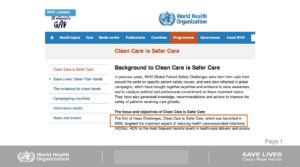Webinar Summary: Healing Hands: The Next Frontier in International Health and Development
Published: May 5, 2015 / Published by Global Handwashing Partnership, WHO, Towson University & London School of Hygiene and Tropical Medicine

This webinar explores the multi-partner discussions on infrastructure and behavior change for hygiene in healthcare facilities.
When we talk about handwashing, we tend to think about washing our hands at home or in schools, but we must also think about hand hygiene in healthcare. Hand hygiene is the entrance door to strengthening healthcare systems and delivery. Currently, every year millions of people get infections that could be prevented if healthcare workers practiced better hand hygiene–including an astounding 5-15% of everyone who receives inpatient hospital care around the world.
That’s why May 5 is the World Health Organization’s call to action day to raise awareness and encourage improvements in hand hygiene in healthcare. In commemoration of this day, and to look more closely at this issue, the Global Handwashing Partnership convened this webinar.
First, we heard from Benedetta Allegranzi, the World Health Organization’s Lead for the Clean Care is Safer Care program, celebrating its 10th anniversary today. The program aims to reduce hospital-associated infections worldwide through awareness raising, mobilizing countries, and producing guidelines and tools, including a self-assessment tool, a guide to implementation of WHO’s multimodal hand hygiene improvement strategy, and posters that define the five moments for hand hygiene in healthcare.
WHO and UNICEF are currently developing a Global Action Plan to address water, sanitation and hygiene (WASH) in health care facilities. This Action Plan is needed. A recent report found that globally, 35% of healthcare facilities lack soap and water or alcohol-based handrub for hand hygiene. The Ebola outbreak shed further light on the dire state of hand hygiene infrastructure in hospitals around the world, a deficit that contributed to the spread of the virus. Over the last ten years, 137 countries have formally committed to take action on hand hygiene in healthcare; Sierra Leone joined today in memory of those working in the health sector who died during the Ebola outbreak.
Cyrus Engineer, Director of the Healthcare Management Program at Towson University and previous country director for Johns Hopkins University operations in Afghanistan, then highlighted some of the challenges faced by post-conflict settings in achieving good hand hygiene, ranging from lack of water and soap in hospital rooms to the water being so cold as to be unusable for hand hygiene, to hand hygiene promotion being dependent on NGO priorities.
However, hand hygiene in healthcare is not all about infrastructure. Robert Aunger from London School of Hygiene & Tropical Medicine shared his work on hand hygiene behavior change in healthcare, with a focus on how to achieve improved hand hygiene for nurses. He identified many challenges, ranging from lack of time to inconvenient locations of hand hygiene facilities, but also noted the factors that made it more likely that nurses would practice good hand hygiene including perceiving oneself as a role model, peer pressure, self-efficacy, perceived risk of infection relative to the benefits of handwashing, and early learning about handwashing with soap at home.
Aunger proposed that it is time to move beyond posters to meaningfully engage health workers in achieving and sustaining good hand hygiene. He identified key evidence-based target interventions including around professional peer group identity, solidarity, affiliation, status, and social norms; feelings of disgust around having contaminated hands; the emotional drive to nurture/provide good care; habit development; and convenient, accessible hand hygiene facilities.
Layla McCay, Secretariat Director for the GHP explained that achieving good hand hygiene is a continuum, recommending that health facilities use the WHO self-assessment tool to identify each facility’s baseline situation, strengths and opportunities for hand hygiene – and then to start working through steps to move health workers from their baseline through to excellent hand hygiene, positively impacting their patients’ health.
Finally, Hanna Woodburn, Deputy Secretariat Director for the GHP highlighted the opportunity to advocate for hand hygiene in healthcare in the upcoming Sustainable Development Goals, strengthening the sustainability of prioritization for hand hygiene in healthcare to drive commitment and investment, using our hygiene advocacy toolkit to get involved in advocating for hygiene.
A recording of the webinar is available here.
- Resource Attachments:
- https://globalhandwashing.org/wp-content/uploads/2017/12/Healing-Hands-webinar-slide-deck.pdf (pdf)
TAGS: Event RecordingMultimedia IntegrationAdvocacy & PolicyHygiene in Health FacilitiesHandwashing Technologies ImplementersPolicy Makers English 2015